Face-Off: EA Sports UFC
Fight Night: The Next Generation?
Our initial analysis of the UFC demo proved mostly positive on both PlayStation 4 and Xbox One, albeit with the Sony system pulling out a small graphical advantage in terms of effects and image quality. However, the overall experience on both platforms didn't feel quite as polished as it could have been: transitions between menus stuttered on-screen, while a few mild performance issues prevented the PS4 game delivering the best possible experience in all areas. With the final game in our grasp, it's time to see if these elements have improved.
After we first insert the UFC disc, a day-one patch starts downloading. This is sometimes a good sign, as developers often make last-minute tweaks and optimisations even after gold master code is dispatched for production, and we hoped that would be the case here, as there had been talk of a resolution upgrade for the final game. However, it's not clear whether anything has actually improved over the one-month-old demo. Navigation of the various menus are still interrupted by stuttering transitions, and more importantly the basic rendering set-up of the game is entirely unchanged.
It's clear that that both versions of UFC still operate using 1600x900 framebuffers in combination with multi-sampling anti-aliasing. As we saw in the demo code, 4x MSAA is present on PS4, reduced to 2x MSAA on the Xbox One, giving Sony's system a tangible increase in overall image quality even if the difference is fairly subtle a lot of the time. A closer look at the edges on Xbox One also reveals some inconsistent transparent pixels around characters and scenery, suggesting a rougher, less refined scaling implementation. This leads to the game looking slightly fuzzier, although when viewing the action from a few feet away on our 32-inch HDTV these artefacts are pretty well concealed by post-processing effects.
Ultimately, the decision to opt for a more smoother, dare we say it, cinematic aesthetic helps to hide the 900p resolution quite well on both consoles, and is clearly a good choice for this particular game, with the rendering technology and art style working successfully together to reduce artefacts and infuse a distinct, realistic appearance. You can get an idea of that in the head-to-head video below, plus our UFC comparison gallery.
"Despite the availability of a day-one patch, it's not immediately clear that anything has been improved over the one-month-old demo."
The use of motion blur, depth of field and fairly low contrast environments clearly helps deliver the best possible image quality. However, these effects also increase the ferocity of combat in the octagonal arena, particularly when delivering more elaborate moves and combos as you aim for a quick knockout. Here the presentation in UFC shares much in common with Fight Night Champion, although the use of post-processing isn't quite so heavy-handed, leading to a better balance between a gritty aesthetic and a cleaner, televised style. The downside is that some of these changes make the fights appear less brutal and hard-hitting than the last Fight Night game. This mainly comes across when powerful attacks aren't followed by a suitably audible thud as they impact forcefully with your opponent.
As we saw in the demo, the PS4 version is more refined where these effects are concerned, with higher-precision object blur and better-quality shadow filtering on Sony's console. Motion blur is a touch heavier on the PS4, as is the use of ambient occlusion, providing a slightly greater amount of depth across character faces than the Xbox One version.
In other areas the two versions match up far more closely - lighting, texture work and shader effects are deployed equally across both formats. Here, the level of detail on the characters really stands out, with subtle blemishes rendered intricately across the surface of their skin, further enhanced by the realistic reflection and refraction of light simulating how these elements behave in real life. The animations are also a high point, changing depending on the position and closeness of your opponent. However, seemingly few of these are unique to each fighter: many animations are duplicated across all combatants for various clinches and grapples. Hopefully we'll see EA begin to address more individual fighting styles in future instalments now that the core groundwork has been laid down.

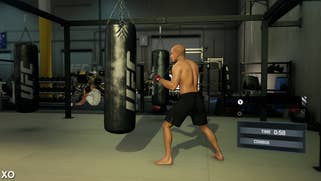
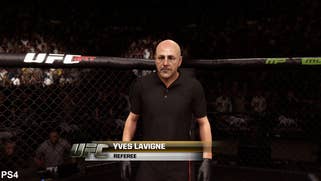

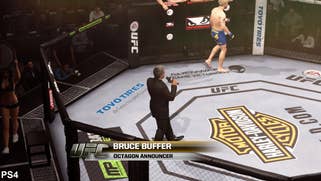

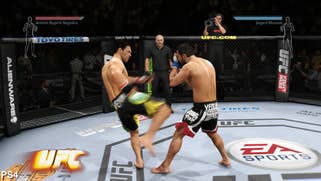
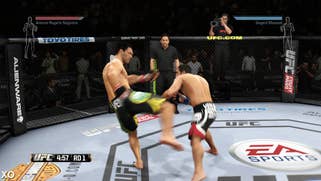
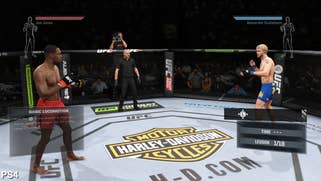

Moving onto performance, UFC adopts a 30fps set-up similar to that of Fight Night Champion, with object blur giving the game a more fluid look than we've come to expect from titles running at this frame-rate. However, in our demo analysis we found the PS4 code fell behind Xbox One in terms of raw stability, and sadly the situation hasn't changed at all in the final game, despite the availability of a launch-day update.
Across different arenas using various combatants, we still see some minor frame-rate drops on PS4 and a few regularly torn frames (limited to the top 10 per cent of the screen, so mostly unnoticeable). The situation has little impact on how the game plays, but the dropped frames do lead to some short but noticeable stutters during both gameplay and cut-scenes on Sony's system. The Xbox One game delivers a clean 30fps presentation without these mild inconsistencies, which makes the experience feel a little more refined where performance is concerned.
Seeing a drop in performance on PS4 comes as a surprise, given the additional GPU power available over Microsoft's new console and that both versions of UFC are operating at 1600x900 resolution. Perhaps the use of 4x MSAA on Sony's console is the cause, given that higher levels of multi-sampling can consume a considerable amount of bandwidth and GPU resources.
"While gameplay is basically unaffected, the appearance of dropped frames leads to very slight stutter during the match and cut-scenes on the PS4 version of UFC. "
Alternative analysis:
EA Sports UFC: the Digital Foundry verdict
EA's next-gen only UFC title can be considered a success overall, even if the revelatory jump in fidelity we saw in the last-gen Fight Night series isn't replicated here. Similar to Fight Night Champion, the use of a 30fps frame-rate and liberal use of post-processing creates a more intense and almost cinematic feel that works well. However, with all that extra power on tap in the new consoles we can't help wonder whether GPU resources should have been deployed on a 60fps gameplay experience rather than the post-processed, smoother look here. TV shows are generally shot on film at 24fps, while sport is presented via video at 60Hz. We applaud the developer's approach to fidelity, but perhaps a higher frame-rate would have made for better gameplay and would have been a closer match for the sport's presentation in real life.
Perhaps combining the benefits of stronger effects work alongside higher frame-rates could be possible in the future as developers extract more performance from the new wave of console hardware. However, in the here and now, EA manages to deliver a fairly solid mixed martial arts experience across both consoles, featuring accomplished effects and lighting and some incredibly detailed texture work that helps bring the realistically modelled characters to life. The result is a game that captures the spirit and technical complexity of the genre, even though the array of button presses and control options certainly proves daunting for the uninitiated.
In the multi-platform stakes the PS4 game benefits from superior effects work and better image quality, giving this version a slightly more refined look. Performance is a little more solid on Xbox One, but the pros and cons for each version have minimal impact in terms of the impact on gameplay. Overall, the PS4 version of UFC nudges ahead but it must be said that the experience is virtually interchangeable across both consoles. With that in mind, if the bulk of your competition lies with Xbox One owners online we have no hesitation in recommending that version too.







